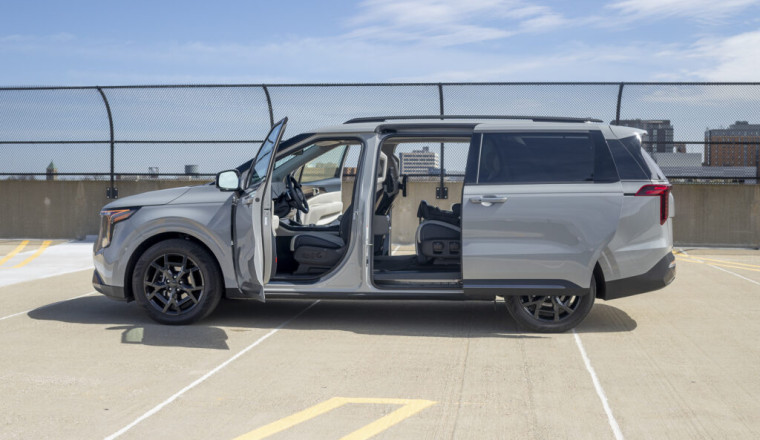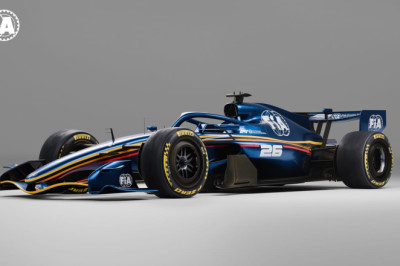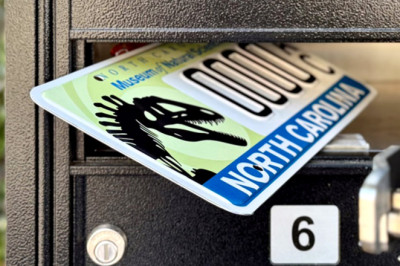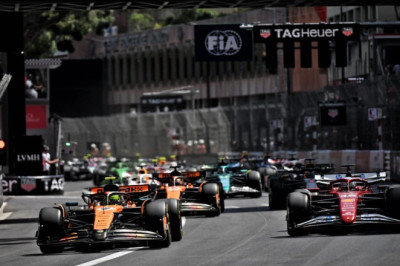
Three years ago, my colleague David Zenlea evaluated the 2022 Kia Carnival. It was just after the birth of his second child. Usually dignified in his writing, Zenlea struck an effusive, almost blissful tone upon sampling the minivan’s dual sliding doors, deep cargo area, and copious kid-entertainment doo-dads. Having just tested the 2025 Kia Carnival hybrid, I now fully understand his ecstasy.
My first was born last October, which means she still faces rearward in her infant car seat, and thus did not experience the benefit of Kia’s new high-definition, 14.6-inch rear entertainment screens. I, on the other hand, was awash in utilitarian delight: Massive cargo area with rear seats folded! The stroller just DROPS right into the trunk! I can load the car seat even in tight grocery-store parking lots, thanks to sliding doors! More surprising than my own excitement was my wife’s; she usually gets the “ick” from the mere sight of a minivan, but she was rather taken with the South Korean MPV. Her main reason? “It doesn’t really look like a minivan.”
That sound you hear? It’s me, furiously rubbing my hands together in anticipation of one day owning a kid-toting rig like this.
Well, maybe not just like this. Though the Carnival’s 2025 refresh makes it more attractive inside and out, the new hybrid powertrain isn’t quite ready for prime time. The HEV (Hybrid Electric Vehicle) version gets a 1.6-liter turbocharged four-cylinder, a six-speed automatic transmission, and a 1.5-kWh lithium-ion battery with an electric drive motor. Total output is 242 horsepower, with 74 hp of that coming from the electric motor. Torque is 270 lb-ft.
Torque, by the way, isn’t the issue—the Carnival spins its tires when taking off from a stop, particularly on damp or wet roads. Things smooth out once the Kia is on the go; highway passing is no issue and the drivetrain is very quiet. But the six-speed automatic’s downshifts are rough enough to make the Carnival’s chassis wiggle and buck a bit under braking, especially if there is any steering angle dialed in. In this respect, the Toyota Sienna hybrid is much more refined.
Kia’s e-motor is integrated with the transmission so as to function like a torque converter, sending power to the front wheels either with or without assistance from the gas engine. There is regenerative braking to restore some battery charge, though its operation isn’t especially fluid. Pedal pressure can be inconsistent and hard to judge as the car decelerates. The driver has some control over this, thanks to a little paddle that can select between three regen modes of varying intensity. But even in the most aggressive setting the regen doesn’t offer the kind of one-pedal operation that many hybrid and EV owners like, and once the battery is fully charged, the regen can’t be activated at all. Chrysler doesn’t have that problem and generally nails this aspect of hybrid driving with its long-running Pacifica plug-in and the “L” low-range mode.
EPA-rated numbers are stellar: 34 mpg in the city, 31 on the highway, and 33 combined. That’s a major improvement over the standard Carnival’s 287-hp V-6, which manages 18/26/21 mpg. My fuel economy was five mpg worse than advertised 33, at 28 mpg combined. In fairness, I was hauling around a lot of people and cargo, including my family visiting from out of town and their associated luggage. At no point during these laden trips did the Carnival’s powertrain protest. (Those who regularly tow will be interested to know that the HEV maxes out with a 2500-pound trailer—1000 pounds less than the V-6.)
Zenlea lamented the 2022 Carnival’s handling for its unresponsiveness and ride for its occasional harshness, but Kia seems to have engineered those flaws out of the hybrid version. The HEV gets unique suspension tuning, as well as a few interesting dynamic features involving the electric motor. For one, the motor can subtly decelerate the van to better load the front end, and increase traction when entering a corner or changing lanes. To help stabilize the rear to finish said maneuver, the motor spins up to transfer load in the other direction.
Without a V-6 model to directly compare, it’s hard to say how effective the so-called “E-Handling” is, but on the other hand, not noticing anything amiss suggests it operates pretty well. A similar “E-Ride” feature uses the electric motor to lift or lower the van’s nose to limit shock travel when going over large bumps.
Of course, it’s safe to assume that most Carnival shoppers simply want a functional people-mover with relatively attractive styling, a comfortable interior, materials that resist kids’ attempts to destroy them, and modern technological doo-dads. The top-trim SX Prestige knocks these criteria out of the park. The Carnival retains its best-in-class interior space, with 40 cubic feet of capacity behind the rear seats. Liftover height is low, which means loading and storing luggage is hilariously easy. Exterior updates to the front and rear—note the amber vertical lighting next to the headlights—help the Carnival’s SUV impression, and create a sense of family by closely aping Kia’s Telluride. Smoky 19-inch wheels and that chunky, two-tone C-pillar add to the van’s urban-chic look. The strategy to copy SUV styling is proving savvy; Kia boasts that it has the youngest customers in the segment, 75 percent of which are new to the brand.
The Carnival’s interior also got some love for 2025. New units for the instrument cluster and center screen—both 12.3 inches—together create a large curved panoramic display. Swanky stuff. And for all you Stanley-loving hydro-fiends, the cupholders between the two front seats are now larger. The rear-seat entertainment suite ($2500) now has bigger screens, at 14.6 inches each.
I’m sure a toddler would have loved them for watching Peppa Pig, but in our case they just occupied space behind the front-seat headrests that made it tougher to install a rear-facing infant car seat. Fortunately, the second-row captain’s chairs can slide pretty far north-south (as well as a little east-west). But unlike in other minivans, these seats cannot be removed for ultimate cargo capacity. The so-called “VIP Lounge” setup is more geared toward leather-lined comfort than Home Depot runs to load up mulch and 2x4s.
My wife’s 2011 V-6 RAV4 is great, but when it dies (if it ever does, the beast), I will be applying full-court marital press to replace it with some kind of minivan. Like Zenlea, I have tasted the fruit of practical, sensible utility and there is no forgetting it. But the Carnival isn’t the only show in town. The V-6 Honda Odyssey is quicker and handles better. The Toyota Sienna is about as fuel-efficient, comes as a hybrid by default, and offers all-wheel drive—not an insignificant option in Michigan. And the Pacifica’s plug-in setup means it can run exclusively on battery power around town. But among these various vans, only the Carnival has the visual appeal of an SUV. If Kia can get the hybrid drivetrain sorted, or upgrade to a plug-in for the next generation, it’ll be a contender for my wife’s spot in the garage.
Highs: Un-minivan styling has considerable suburban appeal. Smooth ride. High fuel efficiency.
Lows: Unrefined transmission. Inconsistent brake freel and regen. Non-removable second-row seats.
Takeaway: A minivan that looks like an SUV and feels like a luxury limo inside? Sign us up. But Kia’s hybrid system proves a little rough around the edges.
Two words stopped me. Hybrid and Mini Van.
The two words that stop me are Kia and Hybrid. If you want one of these things get a V6 or don’t bother and get the Honda/Toyota vans.














